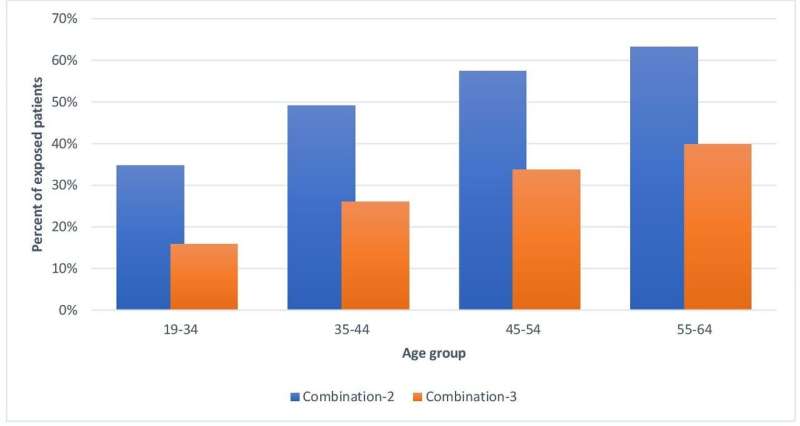May 4, 2023 report
This article has been reviewed according to Science X's editorial process and policies. Editors have highlighted the following attributes while ensuring the content's credibility:
fact-checked
peer-reviewed publication
trusted source
proofread
Study finds doctors prescribing untested drug combinations with high addiction potential

The Center for Drug Safety and Effectiveness at Johns Hopkins University has led a study into prescription drug use of multiple concurrent central nervous system (CNS)-active drugs. They found widespread combination prescribing of drugs classified as Schedule II controlled substances with a high potential for psychological or physical dependence and with limited combined clinical trial testing.
The paper, "Medical use and combination drug therapy among US adult users of central nervous system stimulants: a cross-sectional analysis," published in BMJ Open, examined patterns of medical amphetamine and methylphenidate stimulant drug use, both substances considered to have a high potential for psychological or physical addiction.
Utilizing prescription drug claims for US adults aged 19 to 64 from a commercial insurance claims database with over 9.1 million continuously enrolled adults, stimulant use was defined as adults filling one or more stimulant prescriptions in a single year.
The study identified 276,223 individuals (3.0%) using Schedule II stimulants in 2020. They filled a median of eight prescriptions that provided 227 days of exposure. Among this group, 125,781 (45.5%) combined use of one or more additional CNS active drugs for a median of 213 days. Also, 66,996 (24.3%) stimulant users used two or more additional CNS-active medications for a median of 182 days. Among stimulants users, 131,485 (47.6%) used an antidepressant, 85,166 (30.8%) filled prescriptions for anxiety/sedative/hypnotic medications and 54,035 (19.6%) received opioid prescriptions.
Many adults using Schedule II stimulants simultaneously use one or more additional CNS-active drugs. As these can have tolerance and withdrawal effects or potential recreational abuse, the authors suggest that "discontinuation may be challenging," which is another way of stating that these individuals have likely formed a habitual dependence or addiction possibly requiring intervention or rehabilitation.
In a previous study, the team found a 79% increase in stimulant use in adults over a 5-year span. The current study shows how the stimulants are being utilized, revealing several concerning patterns.
Once treatment has started, 75% of patients become long-term users. This underscores the possible risks of non-medical guideline use, noting the issues that warranted the classification of these drugs as having a high potential for psychological or physical dependence and their prominent appearance in toxicology drug rankings of fatal overdose cases.
Data illustrated a different application of amphetamine and methylphenidate products beyond their primary approved use as monotherapy for adult ADHD. Nearly half the exposed population was being prescribed these drugs in combination with one or more other psychiatric drugs, including 24.3% with two or more additional psychiatric drugs.
While there have been clinical trials for each drug, none have been conducted on taking three or four at the same time. Because clinical trials have yet to take place, it is unclear what the patient indicators or treatment outcome goals for such interventions should be, meaning patient outcomes are also currently unknown. It might not even be possible to perform a study with some of the drug combinations due to patient safety and ethical concerns under good clinical practice guidelines.
The study identified patients who may be getting stimulants or other psychiatric drugs as part of a prescribing cascade. For example, 9.5% of the population getting a potent stimulant of the CNS were also taking alprazolam, an anxiolytic/sedative/hypnotic drug.
The data does not indicate which intervention may have come first—a stimulant added to compensate for excess sedation from the benzodiazepine or the alprazolam added to calm excessive CNS stimulation or insomnia from the stimulants. Alprazolam has a boxed warning for "abuse, misuse, and addiction," as well as dependence and withdrawal reactions. This makes it harder for the patient to stop using either or both drugs. In addition, 15.5% of stimulant patients also took DEA Schedule II opioids.
The study reveals significant gaps in knowledge and oversight within the medical community. Where clinical trials normally inform clinical treatments, the prescribing of multi-combination drug cocktails has yet to go through that process. Even if based on some existing knowledge within the medical or pharmaceutical community, that knowledge still needs to be scientifically tested in trials, otherwise, they are experimental treatments.
Strict federal rules exist to protect patients in research trials. These experiments by prescription are missing many of the basic tenets of good clinical practice.
More information: Thomas J Moore et al, Medical use and combination drug therapy among US adult users of central nervous system stimulants: a cross-sectional analysis, BMJ Open (2023). DOI: 10.1136/bmjopen-2022-069668
© 2023 Science X Network




















